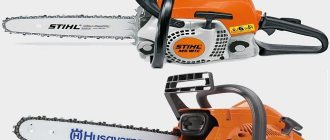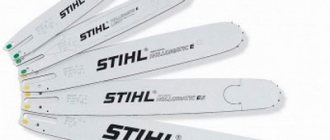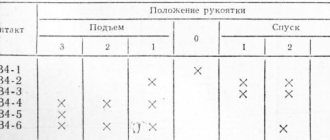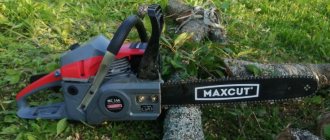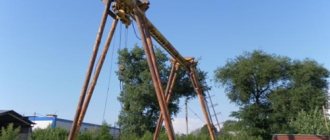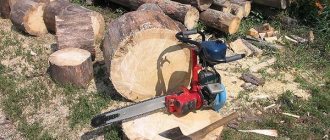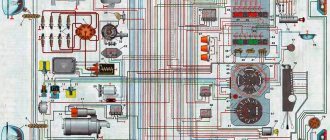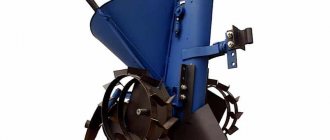Home pageReviewsGardening equipment/Tools, building materials, technologiesWhich is better and more reliable - a chainsaw, electric or cordless chainsaw
Which chain saw is best for the household? Which one to choose - a gasoline, 200-volt electric saw or a battery-powered one? Overview of options, pros and cons when choosing a chain saw for home, garden or work.
What country farm can you imagine without a chain saw? Well, how else can you cut firewood these days, and during construction, a chain saw generally becomes the No. 1 tool for many. There is no doubt that such a thing should be available in any country house. That’s what we’ll talk about, namely the chain saw and its types. Today, the chain saw is presented in three variations - gasoline, corded and battery-powered. When faced with a choice between a gasoline and electric saw, many cannot decide which option will be more reliable and practical. In this review, we will try to understand the strengths and weaknesses of this tool, we will compare gasoline, corded and battery-powered saws, and also consider their pros and cons, after which, I hope, you will be able to make the right and meaningful choice, understanding what type of device most suitable for you. When buying a chain saw, the main thing is to clearly define for yourself what goals are pursued when purchasing this tool? If you need a saw just to cut firewood at home, this is one thing, for a home hobby that you do from time to time, this is another, but if you are a builder, this is a third matter.
Design features of electric and gasoline chain saws
Chainsaw device
The basic unit of the chainsaw is a high-speed engine (12 - 14,000 rpm), with a volume of 40 - 60 cm3. A special feature of this engine is that A92 or AI95 gasoline is mixed with a special oil immediately before filling the tank. If you fill a chainsaw with pure gasoline, the engine will fail a few seconds after starting.
With the engine blocked:
- centrifugal clutch;
- drive sprocket;
- tire;
- chain lubrication oil pump;
- brake.
The engine is started with a manual starter (cord). The chainsaw handle is equipped with an anti-vibration mechanism and special inertial protection - if the saw chain jams, it can be thrown back strongly, and there is a real possibility of injuring the sawyer. The safety bar, upon contact with the operator's hand, instantly stops the engine and eliminates the possibility of damage from the rotating chain.
Saw chains are used in several types; to select them, the classification most often used is by pitch - the distance between the lower teeth that engage the drive sprocket.
The chain thickness is in the range of 1.3 – 1.6 mm. For household and semi-professional saws, a chain with a thickness of up to 1.45 mm is sufficient; for professional saws used for felling forests, chains with a thickness of 1.5 - 1.6 mm are required.
1 . Tire. 2 . Chain. 3 . Inertial chain brake. 4 . Cylinder cover.
5 . Starter handle. 6 . Safety trigger. 7 . Gas trigger. 8 . Throttle lever.
9 . Rear handle. 10 . Oil tank cap. eleven . Front handle. 12 . Fuel cap.
Electric chain saw device
The saw set of an electric saw is similar in design to a chainsaw. But electric saws, as a rule, do not have a clutch; instead, a soft start button is provided. In many cases, this is completely insufficient - idling mode, when the motor is running but the chain does not move, is more convenient and safer.
In terms of engine power, electric saws are significantly inferior to gasoline ones - the maximum power does not exceed 2.5 kW. Attempts to create more powerful electric saws have not been successful - the weight of the engine and power consumption sharply increase, which affects both the convenience of the tool and its cost.
In most cases, every electric saw has a safety arc and works on the same principle as on a gasoline one. An oil pump is also present - often pumps of the same model are installed on electric saws as on chainsaws. They provide chain and tire lubrication in all operating modes. The intensity of oil supply depends on the chain speed.
It is worth noting that one of the main mistakes of power saw users is hidden here. If in a chainsaw oil is poured into the pump tank at each refueling, then when operating the chainsaw this is often forgotten. This leads to rapid wear of the saw set and frequent replacement of chains and bars.
There is a misconception that on electric saws the chain and bar wear out faster due to low speeds. If you add oil on time, the service life of the saw set is the same in both cases. Only productivity depends on the speed.
1 . Lever. 2 . Electric motor. 3 . Oil tank plug.
4 . Inertial chain brake 5 . Tire.
6 . Chain. 7 . Screw securing the bar and chain tension.
Differences in power, performance, saw set and price
Power and performance
As already mentioned, the power of electric saw engines rarely exceeds 2.5 kW, while for chainsaws it can reach 5 – 6 kW. But even a 2.5 kW electric saw cannot match the performance of a gasoline saw of similar power. The fact is that an electric saw at an average load can operate continuously for up to 40 minutes, after which it must be turned off for 20 minutes so that the motor cools down.
Chainsaws do not have this problem, unless you take into account cheap household-grade tools. Semi-professional and industrial ones do not require such stops and can work 8 hours a day almost without stopping. The time for refueling with fuel and oil does not count - this operation takes several minutes. It is also worth considering that oil is also poured into electric saws.
The speed of the chainsaw chain is 25 - 30% higher than that of an electric one. Accordingly, productivity increases just as much. Given the ability for the operator to quickly move with a chainsaw around a construction site or along a board or log, which is difficult for an electric saw due to the presence of a cable, productivity increases even more. If you compare a chainsaw and an electric saw of the same power, then the performance of a gasoline saw is slightly higher.
Saw set
Electric and gasoline saws are equipped with the same saw set, with chains of the same pitch and tooth profile. But the length of the bar, and, accordingly, the number of teeth on the chain, differ. Chainsaws are equipped with tires ranging from 35 cm to 1 m in length, depending on engine power. Electric saws are equipped with tires no more than 0.5 - 0.6 m.
But this parameter is not as important as it might seem. It is correct to compare only saws of the same power, and chainsaws with 2.4 - 3 kW motors rarely have tires longer than 0.5 m. So, in this parameter, the tools are approximately equal. In forestry operations where saws with meter-long tires are required, electric saws do not work, so there is no point in comparing them.
Price
When choosing a chainsaw or electric saw, price does not play a determining role. Performance properties are much more important. But if you take semi-professional saws, for example the STIHL 180 chainsaw and the Makita UC4020A electric saw (comparable power 1.5 and 1.8 kW), then the price of the electric saw is almost 40% lower than the gasoline one.
Owner reviews
Dmitry, Chernivtsi:
“Guys on the forums write different things, it’s doubtful to believe all the advice. Of course, you need experience. I’ll tell you about my experience too: I have two electric saws on my farm, the domestic Dnipro and the German Shtil. I’m very pleased with these tools, a chainsaw is essentially only needed to cut wood in the forest for firewood or just pieces of wood for a fire, and in my opinion it’s not an essential item for a household, although it’s nice to have it. The electric saw is better in all respects. Power up to 1500 W is enough, and there is no fuss with gasoline.”
Gennady, Boyarka:
“As a chainsaw owner, I will say that the tool is not the most trouble-free, but the power is worth it. I use the Swedish Husqvarna 236, its power is 1400 W. To be honest, even with a strong desire, I can’t name a single significant drawback, because the Husqvarna saw is quality and has no headaches during maintenance; it works well. And when the opportunity arises and the budget allows, I also want to buy an electric saw from the same manufacturer, even though they are expensive compared to gasoline ones.”
Difficult to maintain and use
Preparation for work and maintenance
Electric saws are more convenient when preparing for work. It is enough to install the saw set, add oil and plug the plug into the socket. However, most high-quality electric saws are equipped with quick-release devices that allow you to tighten the chain or replace it in a few minutes.
Quick-release chain tensioner.
With chainsaws this is more difficult - semi-professional and professional saws are equipped with traditional clamps on nuts, which cannot be disassembled without a key. And the chain is tightened using a screwdriver or a special hex key. This takes a little longer, but the settings are guaranteed to hold tightly.
Regular chain tensioner.
Preparing the fuel mixture for a chainsaw takes a few minutes - special graduated containers allow you to mix gasoline and oil in a given proportion in any quantity. As a rule, one tank refill is enough for 40 – 50 minutes of operation. Having prepared 2-3 liters of fuel in the morning, you will be provided with it for the whole working day. You should not prepare the mixture for future use for several days; its properties deteriorate during long-term storage.
Comfort of use
An electric saw does not require a fuel mixture. To start sawing, just insert the plug into the socket and press the button.
However, if chainsaws are perfectly balanced and very comfortable to hold in your hands, then with electric saws the situation is more complicated. In addition to the fact that the cable interferes quite noticeably, they are also produced in two types of motor locations - longitudinal and transverse.
Rip saws are distinguished by the location of the axis of rotation of the motor shaft along the direction of the tire. They are small in width, but quite long. Although they are perfectly balanced, the presence of a cable limits their mobility.
Crosscut saws are short, but the motor housing protruding to the left side upsets the balance and requires some effort from the operator to keep the bar in the cutting line. The effort is small, but with prolonged work it increases the level of fatigue. The inconvenience from the cable in such saws is felt less.
Safety
In terms of safety, chainsaws are ahead of electric ones due to the absence of an electrical cable, which you have to constantly pay attention to. Electric saws cannot be used in damp and rainy weather, as well as in damp rooms.
Regarding possible injury from the cutting part, the saws are absolutely identical; injury can only be caused by gross violation of the operating rules.
Lever to instantly stop the chain in the event of a kickback. It is equipped with both electric and gasoline chain saws.
Ultimately, it is quite difficult to determine which is better than an electric or chainsaw. It all depends on the specific tasks and operating conditions. Judging by the prevalence and popularity of tools, both types of chain saws have a right to life and do an excellent job with their tasks. It is only important to buy a quality instrument, and not cheap fakes.
Chainsaw or electric saw: which is better to choose?
Before purchasing a tool for your needs, you should understand its technical characteristics and compare them with your needs.
First of all, we need to clearly define our needs. If we use a saw in our own garden, then most often the tool is required to cut the cut tree into smaller pieces; for this it is enough to have a compact, convenient electric saw, powered from a regular power outlet.
However, if the job requires more power or we have to work in harsher conditions, away from a power source, it will be necessary to purchase a high-quality chainsaw. Both the first and second types of saws are currently represented on the market by many models, and at least several manufacturers are global brands specializing in this equipment.
It is always important to compare offers not only in terms of price, but also in terms of parameters, because the performance of the tool in specific conditions will mainly depend on them.
First of all, the most important decision will be the choice of engine, as well as other main parameters, let’s look at them in more detail. Below are comparative characteristics, advantages and disadvantages of saws that will help you choose and buy the right chainsaw or electric saw.
General parameters that are very important when using this device on a daily basis.
- Versatility. Naturally, when buying more expensive equipment, we want it to serve us as often as possible and for different needs. Therefore, it is worth choosing models that are useful, for example, for cutting down trees in the garden, as well as for cutting bars for fuel. Of course, a lot depends on our needs, but greater versatility means lower operating costs.
- Safety – Although modern saws are equipped with safety systems, it is always a good idea to double-check the safety systems when working with such a dangerous tool. The device must have an overheating prevention system, safety switches and quick start.
- Environmentally friendly - Much depends on the efficiency of the energy system itself, which, for example, consumes less electricity or fuel and therefore has lower emissions. Many manufacturers have their own, very strict standards in this area, often certified.
- Operating comfort – Provided by features such as quiet operation and comfort (important for long-term use), performance and wireless connectivity. These qualities are especially important for professional models intended for higher demands. But the most expensive option is not always the best for our needs.
Electric and chainsaws have been in use for a long time, so individual models have evolved so much that it is sometimes difficult to find the only device of your dreams in a huge range. However, paying extra for equipment that is used once or twice a year is not always advisable. Let's analyze what we need, what functions are most important to us. Then the likelihood that we will buy a good device that meets our expectations will increase significantly.
Suitability of electric and gasoline chain saws in various conditions
It is possible to determine which saw is better than an electric or gas saw only based on the tasks it will have to perform. When using a chain saw at home, when you need to saw through several logs or make blanks from boards, both options are approximately the same in ease of use and performance.
But if you have to cut down a tree in the garden or clear a hedge, then a chainsaw is much more convenient. It is mobile, lightweight and works in any weather. The radius of use of the electric saw is limited by the length of the electric cable. It is not safe to use it in rainy weather or even with heavy dew.
When working indoors, the palm should be given to the electric saw if the work is carried out within one or two rooms. The absence of exhaust gases is a significant advantage, as is the noise level. If the sound from the operation of an electric saw rarely exceeds 75 dB, then the chainsaw even at idle “produces” more than 80, and during operation - up to 100 - 105. On the street this is quite acceptable, but in a confined space it is very uncomfortable for both the sawyer and the the people around him.
The vast majority of electric chainsaws are made for domestic use. Their main purpose is to work in the garden and summer cottage with small volumes of work, as well as during construction and carpentry work.
Chainsaws are intended for frequent and prolonged use. They are able to work for a long time in almost any conditions.
Let's sum it up
When choosing a chain saw, think carefully about the purposes for which you need it. When goals are clearly visible, it is much easier to make a choice and make a decision in favor of one option or another.
Many, oddly enough, have both a gasoline and a corded saw, and some even have a battery-powered one. Therefore, weigh carefully and consider everything. Let me finish here, I wish you only a reliable and working tool, do not forget to subscribe, and if you liked the video, put your likes, good luck to everyone and see you again.
Permanent address of the article: https://stroimasterskaya.ru/reviews/3075 with the support of the YouTube channel CleverBILL
Show more articles from the category - Garden equipment
Final comparison of electric and gasoline chain saws
| Chainsaw | Electric chain saw | |||||||
| Engine power, kW (hp) | 1,3 — 1,5 (1,7 — 6,8) | — | ||||||
| Power consumption, kW | — | 1,6 — 2,2 | ||||||
| Weight, kg | 4,0 — 7,5 | 3,5 — 6,0 | ||||||
| Tire length, cm | 30 — 100 | 30 — 45 | ||||||
| Chain brake | ||||||||
| Design | More complex | Less complex | ||||||
| Preparing for work | Difficult for beginners | Less complex | ||||||
| Working in the forest | Great fit | Unsuitable | ||||||
| Work on construction sites and warehouses | Depends on conditions | Great fit | ||||||
| Work in the country | Great fit | Great fit | ||||||
| Working in small spaces | Unsuitable | Great fit | ||||||
| Service | More complex | Less complex | ||||||
| Durability | Depends on the quality of the tool and proper use. | Depends on the quality of the tool and proper use. | ||||||
If you notice an error, a non-working video or link, please select a piece of text and press Ctrl+Enter .
0
Briefly about the main thing
The question of choosing a saw for the household comes down to comparing the characteristics and capabilities of a gasoline and electric motor. The criteria are parameters such as power, engine size, guide length, and unit weight. Depending on these data, a tool is selected for decorative pruning of trees, for construction purposes, sawing firewood, and processing boards.
Question
Write in the comments what you think - which tool will be more stable (reliable) in winter work, an electric or chainsaw?
